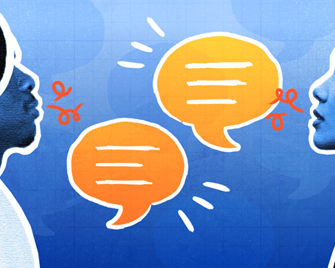Wisdom is the reward you get for a lifetime of listening when you would have rather talked.
– Mark Twain

What are examples of active listening?
How do we build the self awareness to ensure we don’t fall into a default approach of passive listening, where we tune people out, give half of our attention, or simply wait for our own turn to speak?
Here are a couple of examples of what it can look like in the real-world.
*** Passive listening: Your direct report has stopped by your desk to vent about an interpersonal conflict that’s happening on your team. You listen to their side of the story while simultaneously clearing out old emails, occasionally butting in to offer some advice or encouragement and prove that you’re paying attention.
✅ Active listening: You remove your hands from your computer keyboard, silence your phone, and turn to fully face your direct report. You wait until they’re finished before paraphrasing the details of the conflict and asking some follow-up questions.
*** Passive listening: A colleague is walking you through the steps of a process that you’re going to take over. You follow along quietly and politely (while mentally making the rest of your to-do list for the day). There are a few steps that are unclear, but you figure that you’ll sort it out later. You just need to get through this meeting.
✅ Active listening: As the colleague breaks down the process, you ask clarifying questions to dig deeper into any confusing steps. When your coworker is finished, you quickly summarize the gist of the process and your plan for what you’ll do next and when you’ll take over.
The word ‘listen’ contains the same letters as the word ‘silent.’
– Alfred Brendel
Why is active listening important?
Active listening is about listening to understand rather than just to hear. That isn’t inherently difficult —but it does require much more of a conscious effort than the passive approach most of us normally take.
Is it worth the effort? Absolutely. Active listening offers a number of advantages:
1. It boosts understanding
The very point of active listening is to boost comprehension. When it’s done correctly, both the sharer and listener will have opportunities to ask questions, provide feedback, and work together to reach a mutual understanding.
As a result, it’s an effective communication tool for reducing the crossed wires and miscommunications that can send projects and teams veering off track.
2. It improves relationships
Who are you more likely to approach with a question or problem: the person who gives you only half of their attention or the person who genuinely seeks to understand the information you share and your feelings about it? The second one, right?
We all want to feel seen, valued, and understood, and research shows that the concentration and sensitivity involved with active listening increases trust and benefits our relationships — which can amp up the harmony and collaboration on your team.
3. It reduces bias
It’s human nature that we receive and process information through our own lenses. However, active listening requires that you step outside of yourself and see things from the other person’s point of view. That can greatly reduce the biases and assumptions that we bring into our interactions.
One study of door-to-door canvassers that were addressing anti-transgender prejudice found that a single 10-minute conversation that incorporated “active processing” and “perspective taking” actually reduced prejudice and even increased support for a nondiscrimination law.
When people talk, listen completely. Most people never listen.
– Ernest Hemingway
What are barriers to effective listening?
If active listening is so great, why don’t more of us do it? Well, the short answer is that it doesn’t come naturally — especially since we’ve become so used to dealing with the following challenges and roadblocks:
Too many distractions: You want to listen intently, but your computer keeps dinging with new emails and instant messages. Your phone won’t stop buzzing. You just remembered something that you need to add to your grocery list. Most of us are plagued by constant distractions (both internal and external), and one Harvard study found that the average person’s mind wanders 47% of the time. You can’t be an active listener if those constant interruptions continue to sabotage your focus.
Personal emotions and perceptions: It’s tough to check your own perspective at the door and enter into a conversation with a totally open mind. Whether you’re doing so consciously or not, you’re far more likely to bring in your own perceptions and opinions, which can make it increasingly difficult to put yourself in the speaker’s shoes and understand their point of view. It also means you can spend a lot of the interaction structuring your own defense and argument, rather than listening to comprehend.
Information overload: Some research indicates that the average person’s attention span is a measly eight seconds. Even if that’s a gross underestimate, this much is true: we have a hard time focusing on something for an extended period of time. If your conversational partner isn’t known for their conciseness and instead provides unnecessary details or drones on and on, it becomes that much tougher to stay engaged with the information and commit to actively listening.
Problem-solving: Most of us don’t like problems — we like solutions. So, particularly in circumstances when someone is sharing a challenge or issue, our natural tendency is to jump in with advice or an answer right away. Those interruptions are well-meaning, but they’re also a major barrier to active listening. You’re only listening to find a potential answer, rather than understand the ins and outs of the problem.
